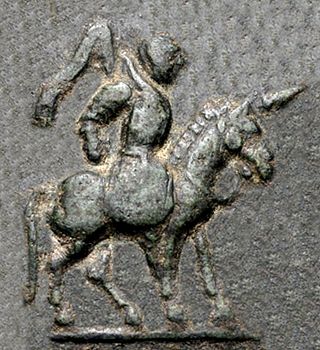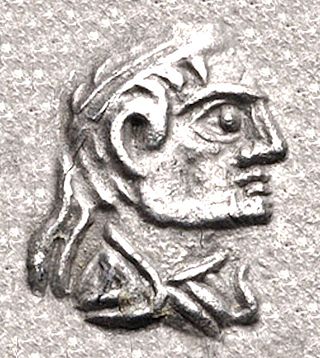
Apollonius of Tyana was a first-century Greek philosopher and religious leader from the town of Tyana, Cappadocia in Roman Anatolia, who spent his life travelling and teaching in the Middle East, North Africa and South Asia. He is a central figure in Neopythagoreanism and was one of the most famous "miracle workers" of his day.

Demetrius I Anicetus, also called Damaytra was a Greco-Bactrian and later Indo-Greek king, who ruled areas from Bactria to ancient northwestern India. He was the son of the Greco-Bactrian Kingdom's ruler Euthydemus I and succeeded him around 200 BC, after which he conquered extensive areas in what is now southern Afghanistan, Iran and Pakistan and India.

Taxila or Takshashila is a city in the Pothohar region of Punjab, Pakistan. Located in the Taxila Tehsil of Rawalpindi District, it lies approximately 25 kilometres (16 mi) northwest of the Islamabad–Rawalpindi metropolitan area and is just south of the Haripur District of Khyber Pakhtunkhwa.
Gandhara, was an ancient Indo-Aryan civilization centered in present-day north-west Pakistan and north-east Afghanistan. The core of the region of Gandhara was the Peshawar and Swat valleys extending as far east as the Pothohar Plateau, though the cultural influence of Greater Gandhara extended westwards into the Kabul valley in Afghanistan, and northwards up to the Karakoram range. The region was a central location for the spread of Buddhism to Central Asia and East Asia with many Chinese Buddhist pilgrims visiting the region.

The History of Punjab refers to the past history of Punjab region which is a geopolitical, cultural, and historical region in the northwest of South Asia, comprising western Punjab province in Pakistan and eastern Punjab state in India. It is believed that the earliest evidence of human habitation in Punjab traces to the Soan valley of the Pothohar, between the Indus and the Jhelum rivers, where Soanian culture developed between 774,000 BC and 11,700 BC. This period goes back to the first interglacial period in the second Ice Age, from which remnants of stone and flint tools have been found.

The Indo-Greek Kingdom, or Graeco-Indian Kingdom, also known historically as the Yavana Kingdom (Yavanarajya), was a Hellenistic-era Greek kingdom covering various parts of modern-day Afghanistan, Pakistan and northwestern India. This kingdom was in existence from c. 200 BC to c. 10 AD.
The Indo-Parthian Kingdom was a Parthian kingdom founded by Gondophares, and active from 19 CE to c. 226 CE. At their zenith, they ruled an area covering parts of eastern Iran, various parts of Afghanistan and the northwest regions of the Indian subcontinent. The rulers may have been members of the House of Suren, and the kingdom has even been called the "Suren Kingdom" by some authors.

Gondophares I was the founder of the Indo-Parthian Kingdom and its most prominent king, ruling from 19 to 46. He probably belonged to a line of local princes who had governed the Parthian province of Drangiana since its disruption by the Indo-Scythians in c. 129 BC, and may have been a member of the House of Suren. During his reign, his kingdom became independent from Parthian authority and was transformed into an empire, which encompassed Drangiana, Arachosia, and Gandhara. He is generally known from the Acts of Thomas, the Takht-i-Bahi inscription, and silver and copper coins bearing his visage.

The Indo-Scythians were a group of nomadic people of Iranic Scythian origin who migrated from Central Asia southward into the northwestern Indian subcontinent: the present-day South Asian regions of Afghanistan, Pakistan and northern India. The migrations persisted from the middle of the second century BCE to the fourth century CE.

Sirkap is the name of an archaeological site on the bank opposite to the city of Taxila, Punjab, Pakistan.

Maues was the first Indo-Scythian king, ruling from 98/85 to 60/57 BCE. He invaded India and established Saka hegemony by conquering Indo-Greek territories.

Zoilus II Soter was an Indo-Greek king who ruled in eastern Punjab. Bopearachchi dates his reign to c. 55–35 BC, a date approximately supported by R. C. Senior. It is possible that some of his coins were issued by a separate king, Zoilus III.

Vardanes I was a king of the Parthian Empire from 40 to 46 AD. He was the heir apparent of his father Artabanus II, but had to continually fight against his brother Gotarzes II, a rival claimant to the throne. Vardanes' short reign ended when he was assassinated while hunting at the instigation of a party of Parthian nobles.

Sases, also known as Gondophares IV Sases, was an Indo-Parthian king and Apracharaja who ruled in Gandhara. He is only known from coins and ruled for at least 26 years after succeeding Gondophares. At some point during his reign he assumed the title Gondophares, which was held by the supreme Indo-Parthian rulers.

The History of the Indo-Greek Kingdom covers a period from the 2nd century BCE to the beginning of the 1st century CE in northern and northwestern Indian subcontinent. There were over 30 Indo-Greek kings, often in competition on different territories. Many of them are only known through their coins.

Life of Apollonius of Tyana, also known by its Latin title Vita Apollonii, is a text in eight books written in Ancient Greece by Philostratus. It tells the story of Apollonius of Tyana, a Pythagorean philosopher and teacher.

The legacy of the Indo-Greeks starts with the formal end of the Indo-Greek Kingdom from the 1st century, as the Greek communities of central Asia and northwestern India lived under the control of the Kushan branch of the Yuezhi, Indo-Scythians and Indo-Parthian Kingdom. The Kushans founded the Kushan Empire, which was to prosper for several centuries. In the south, the Greeks were under the rule of the Scythian Western Kshatrapas.

The sources used to reconstruct the history of the Indo-Greeks are few and disparate, leading to much uncertainty about the precise state of the Indo-Greek kingdom and its chronology. Sources related to the Indo-Greeks can be classified into various categories: ancient literary sources from both the West and the Indian world, archaeological sources from the general area of present day Pakistan, Kashmir and North Indian states of Punjab, Haryana, Himachal Pradesh, Uttar Pradesh & Bihar, and numismatical sources, which are abundant and well-preserved but often rather cryptic.

Jandial near the city of Taxila in Pakistan is the site of an ancient temple well known for its Ionic columns. The temple is located 630 meters north of the northern gate of Sirkap. The Temple was excavated in 1912–1913 by the Archaeological Survey of India under John Marshall. It has been called the most Hellenic structure yet found on Pakistani soil.

The Post-Mauryan coinage of Gandhara refers to the period of coinage production in Gandhara, following the breakup of the Maurya Empire. When Mauryan central power disappeared, several small independent entities were formed, which started to strike their own coins, defining a period of Post-Mauryan coinage that ends with the rise of the Gupta Empire in the 4th century CE. This phenomenon was particularly precocious and significant in the area of Gandhara in the northwest, and more particularly in the city of Taxila, in modern-day Pakistan.